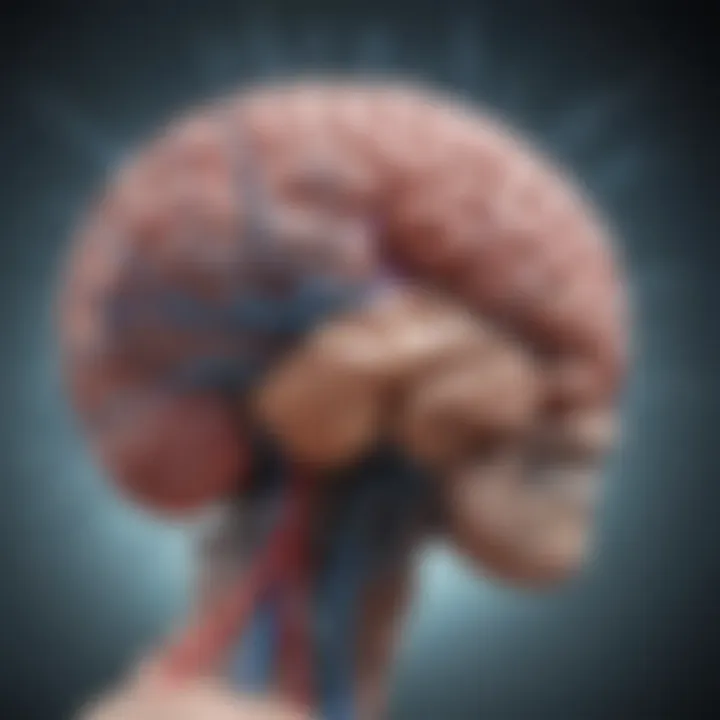In-Depth Insights into Genetic Brain Disorders


Intro
Genetic brain disorders represent a significant area of focus in the field of neuroscience. These disorders arise from genetic mutations or abnormalities that impact brain function. Understanding these conditions is crucial, as they encompass a wide range of neurological issues, from cognitive impairments to severe psychiatric disorders. This overview will explore the intricate linkage between genetics and neurological health, emphasizing both the biological underpinnings and the clinical implications.
Research Overview
Summary of Key Findings
Recent research indicates a growing understanding of how specific genetic alterations contribute to various brain disorders. For instance, mutations in the SCN1A gene are linked to epilepsy, while abnormalities in HTT gene are known to cause Huntington's disease. These findings highlight the need for precise diagnostic techniques that can identify genetic markers associated with neurological conditions.
Background and Context
The advent of genomic technology has paved the way for a clearer picture of genetic disorders. Researchers utilize exome sequencing and genome-wide association studies to uncover mutations that correlate with brain disorders. This approach not only aids in diagnosis but also helps to understand the etiology of diseases, possibly leading to innovative treatments.
Methodology
Experimental Design
Studies on genetic brain disorders often involve both clinical and laboratory research. Clinical studies may include patient cohorts with diagnosed conditions, while laboratory research typically explores cellular or animal models to investigate genetic mechanisms.
Data Collection Techniques
Data collection is predominantly through bioinformatics tools and genetic databases, such as the Online Mendelian Inheritance in Man (OMIM). Patient samples are analyzed using advanced genomic sequencing technologies to detect mutations or variants in associated genes. Collaboration between geneticists, neurologists, and data scientists further enriches the understanding of these complex disorders.
The understanding of genetic brain disorders requires advanced interdisciplinary approaches that bring together diverse fields of study to comprehend these multifaceted conditions.
Researchers also use neuroimaging techniques to study brain structure and function in conjunction with genetic data. This comprehensive approach helps to construct a more detailed picture of how genetic factors influence brain health.
Prologue to Genetic Brain Disorders
The significance of understanding genetic brain disorders cannot be overstated. These disorders present complex challenges not only in medical diagnosis and treatment but also in our significance of human health. Genetic factors play a crucial role in the development and progression of numerous neurological conditions that affect millions worldwide. Therefore, diving deep into these aspects highlights the importance of genetic research and its implications in neurology.
Genetic brain disorders include a diverse range of conditions that stem from mutations or alterations in the DNA. Their impact on individuals extends beyond mere physical symptoms. These disorders can influence cognitive abilities, emotional wellbeing, and overall quality of life. Consequently, gaining insight into this topic is vital for medical practitioners, researchers, and educators, who seek to grasp the intricate relationship between genetics and brain function.
Understanding genetic brain disorders allows for better classification, leading to more precise and effective interventions. Through comprehensive exploration, one uncovers the underlying genetic mechanisms, which in turn guides the way toward targeted therapies and supportive measures.
In this section, we will first define genetic brain disorders, providing clarity in distinguishing them from other types of neurological conditions. Furthermore, highlights will also be made about how genetics fundamentally influences neurological function. These foundational insights will set the stage for deeper discussions regarding classifications, notable disorders, diagnostic methods, and treatment options.
Classification of Genetic Brain Disorders
Understanding the classification of genetic brain disorders is essential for numerous reasons. Firstly, it provides a framework for researchers and clinicians to identify the unique characteristics of each disorder. This classification helps in diagnosing conditions accurately based on symptoms and genetic testing results. Moreover, knowing the specific category of a disorder can guide treatment choices and inform families about potential impacts on health.
The classification into distinct categories also allows for better communication among medical professionals and helps facilitate research. When disorders are categorized, it becomes easier to share findings and compare data across studies. Additionally, it serves educational purposes, making complex information more accessible to students and professionals in the field. Overall, a clear classification system is vital for advancing the understanding and treatment of genetic brain disorders.
Chromosomal Disorders
Chromosomal disorders are caused by abnormalities in the number or structure of chromosomes. The human body typically has 23 pairs of chromosomes. When there is an excess or deficit, it can lead to serious conditions. Examples include Down syndrome (characterized by an extra copy of chromosome 21) and Turner syndrome (resulting from a missing or incomplete X chromosome).
These disorders often present with a range of neurological symptoms. Children may exhibit developmental delays, learning disabilities, and behavioral challenges. Early diagnosis is crucial because some interventions can significantly improve outcomes. Genetic counseling is often recommended for affected families to understand inheritance patterns and risks for future offspring.
Single-Gene Disorders
Single-gene disorders originate from mutations in a single gene. These mutations can be inherited in various ways, such as autosomal dominant, autosomal recessive, or X-linked. Cystic fibrosis and sickle cell disease are well-known examples. The impact of these disorders can vary widely, even within families.
Identifying a single-gene disorder can significantly affect diagnosis and treatment. For instance, Huntington's disease commonly manifests in mid-adulthood, but genetic testing allows for early identification. This not only provides individuals with valuable information but also allows for family planning and the management of potential symptoms later.
Mitochondrial Disorders
Mitochondrial disorders are linked to abnormal function in mitochondria, the energy-producing structures within cells. These disorders can affect any part of the body, but they notably influence the nervous system and muscles. Conditions like Leber's hereditary optic neuropathy cause vision loss due to mitochondrial dysfunction.
Mitochondrial DNA is inherited exclusively from the mother, which adds another layer of complexity to these disorders. Diagnosis often involves a combination of genetic testing, clinical evaluation, and sometimes muscle biopsies. Understanding these disorders is crucial due to their unique inheritance patterns and impacts on energy metabolism.
Polygenic Disorders


Polygenic disorders arise from the combined effects of multiple genes and environmental factors. Unlike single-gene disorders, the inheritance patterns are more complex. Examples include Alzheimer's disease and schizophrenia. These conditions do not follow traditional Mendelian inheritance patterns, making them challenging to predict and study.
The focus on polygenic disorders has expanded in recent years, particularly as genetic research advances. Genome-wide association studies (GWAS) have identified numerous genetic variants linked to these conditions. However, environmental factors often intertwine with these genetic predispositions, complicating understanding and management. Recognizing the polygenic nature of many brain disorders is essential for developing effective prevention and treatment strategies.
Notable Genetic Brain Disorders
Genetic brain disorders encompass a range of conditions that significantly impact neurological function and quality of life. Understanding these disorders is crucial for insight into how genetics contribute to various pathologies in the brain. Each disorder listed here demonstrates unique genetic mechanisms and clinical manifestations, shedding light on the broader implications of genetics in neurology.
Alzheimer's Disease
Alzheimer's disease is a neurodegenerative disorder characterized by progressive memory loss and cognitive decline. Its genetic underpinnings involve several risk factors, including mutations in the amyloid precursor protein (APP) and presenilin genes. These mutations lead to abnormal protein aggregation, forming plaques in the brain. The clinical presentation may begin with mild forgetfulness, advancing to a complete inability to carry out basic tasks. Early diagnosis can be vital for managing the disease and might involve genetic counseling for families.
Huntington's Disease
Huntington's disease is a hereditary condition caused by an expansion of the CAG repeat in the HTT gene. It typically manifests in mid-adulthood, presenting with movement disorders, psychiatric symptoms, and cognitive decline. Genetic testing can confirm the diagnosis with high precision, as the presence of the mutation is definitive. This disorder is essential in discussions about gene therapy since it represents an area where potential treatments are being actively researched.
Fragile Syndrome
Fragile X syndrome is a genetic condition linked to a mutation in the FMR1 gene. It is the most common inherited cause of intellectual disability. Children with Fragile X often exhibit developmental delays, social anxiety, and behavioral challenges. Diagnosis is typically achieved through genetic testing. The syndrome highlights the need for targeted educational strategies and behavioral therapy. Awareness of this disorder can foster better supportive systems for affected individuals and their families.
Parkinson's Disease
Parkinson's disease results primarily from the degeneration of dopamine-producing neurons in the basal ganglia. Genetic factors can play a significant role, particularly in early-onset forms of the disease associated with mutations in genes such as SNCA and LRRK2. Clinical symptoms include tremors, stiffness, and bradykinesia. While no cure exists, understanding genetic predispositions helps in developing future therapies and personalized medicine approaches.
Spinal Muscular Atrophy
Spinal muscular atrophy is a degenerative disease affecting motor neurons, often caused by deletions or mutations in the SMN1 gene. This disorder manifests as muscle weakness and atrophy, impacting mobility and respiratory function. Genetic testing provides crucial information for diagnosis and can guide treatment options, including the use of gene therapy such as Zolgensma. Early intervention can significantly improve life expectancy and quality of life for patients.
Genetic Mechanisms Underlying Brain Disorders
Understanding the genetic mechanisms underlying brain disorders is essential for grasping the complex interplay between genetics and neurological health. Genetic mechanisms encompass any genetic alterations that can lead to the development or progression of brain disorders. These mechanisms often explain how genetic predispositions can manifest as clinical symptoms. A comprehensive examination of these elements allows us to appreciate the intricacies of genetic brain disorders and aids in identifying potential interventions and treatment options.
Mutations and Their Effects
Mutations are alterations in DNA sequences that can lead to significant changes in protein function. These changes can disrupt normal neurological functions, leading to various disorders. For example, single nucleotide polymorphisms (SNPs) can cause disruptions in communication between neurons, which contributes to conditions like schizophrenia and bipolar disorder. Other types of mutations, such as insertions or deletions, can lead to more drastic changes, potentially causing neurodegenerative diseases like Alzheimer's.
- Types of Mutations:
- Missense Mutations: Change one amino acid in a protein.
- Nonsense Mutations: Create a premature stop codon, truncating the protein.
- Frameshift Mutations: Alter the reading frame of the genetic code.
Each mutation can have different implications for the brain's structure and function.
Moreover, environmental factors may exacerbate the effects of mutations. For instance, a genetic predisposition may not necessarily lead to a disorder unless triggered by certain environmental factors. This emphasizes the importance of studying mutations within a broader context of individual environments.
Gene-Environment Interactions
Gene-environment interactions refer to the complex relationships between genetic predispositions and environmental factors that influence the expression of genetic disorders. Recent research has shifted focus towards how these interactions can impact neurological health. This understanding is critical because it reveals that the phenotype of a disorder often results from both genetic and environmental contributions.
"The interaction between genetic makeup and environmental influences can significantly affect disease risk and outcome."
In the case of autism spectrum disorder, for instance, it is not only the genetic components but also considerations such as prenatal exposure to toxins that play critical roles.
Important elements of gene-environment interactions include:
- Environmental Stressors: Factors such as trauma, infections, and nutritional deficiencies.
- Epigenetics: Study of how genes can be turned on or off without changing the underlying DNA sequence, often influenced by environmental factors.
Understanding these interactions is crucial in developing targeted interventions and therapies. As researchers uncover more about how genes and environment cooperatively shape brain function, it opens doors for personalized approaches to treatment in genetic brain disorders.
Clinical Manifestations of Genetic Disorders
Understanding the clinical manifestations of genetic disorders is essential in the field of neurology. It allows professionals to identify and address the various symptoms that arise from these conditions, improving patient outcomes. Genetic brain disorders can affect an individual's cognitive, emotional, and physical health. The impact of these disorders varies widely; therefore, recognizing the specific manifestations can guide appropriate intervention strategies and improve quality of life for affected individuals.
Symptoms and Diagnosis


The symptoms of genetic brain disorders can present in diverse ways. Common manifestations include cognitive impairments, such as learning disabilities or intellectual disabilities, impacting memory and reasoning capabilities. Emotional symptoms like anxiety and depression are also typical. Additionally, physical symptoms may include motor dysfunction, seizures, and coordination difficulties, all of which can vary in severity based on the specific disorder.
Diagnosis is crucial for effective treatment planning. It typically involves a comprehensive patient history and a series of tests. Genetic testing plays a vital role in confirming the presence of specific gene mutations. Neuropsychological assessments can assist in evaluating cognitive and emotional health. Physicians may also use family history as a significant indicator to determine the likelihood of a genetic disorder being present. Early diagnosis is often linked to better management of symptoms, leading to improved patient prognosis.
Neuroimaging Techniques
Neuroimaging techniques are invaluable tools in the assessment of genetic brain disorders. These methods allow for a visual representation of the brain's structure and function, aiding in identifying abnormalities associated with specific genetic conditions. Outlined below are a few common neuroimaging techniques used:
- Magnetic Resonance Imaging (MRI): A non-invasive imaging technique that provides detailed images of brain tissues, making it essential for identifying structural anomalies.
- Computed Tomography (CT) Scan: This imaging modality is often quicker than an MRI. It is used to assess brain lesions, hemorrhages, or other abnormalities.
- Positron Emission Tomography (PET) Scan: PET scans evaluate metabolic activity in the brain, revealing areas with abnormal function, which is significant in disorders like Alzheimer’s disease.
"Neuroimaging not only reveals structural differences but can help understand the functional ramifications of genetic disorders."
These neuroimaging approaches enhance diagnostic accuracy and assist in tailoring individualized treatment plans. As technology advances, the capabilities of neuroimaging continue to improve, offering better insights into the complex relationship between genetics and brain function.
Through ongoing research and utilization of these techniques, the field strives to enhance understanding and management of genetic brain disorders.
Diagnostic Methods in Genetic Brain Disorders
Diagnostic methods play a crucial role in understanding and managing genetic brain disorders. Given the complex nature of these disorders, accurate and timely diagnosis is essential for implementing effective treatment strategies. The methods employed can differ significantly depending on the specific disorder in question and the symptoms presented by the patient. In this section, we will explore various diagnostic techniques and their significance in identifying genetic brain disorders.
Genetic Testing
Genetic testing has become a cornerstone of diagnosing genetic brain disorders. This method involves analyzing an individual’s DNA to identify mutations or abnormalities in genes that may contribute to neurological conditions. Several types of genetic tests exist, including:
- Single-gene tests: These tests focus on specific genes known to be associated with certain disorders. For example, testing for mutations in the HTT gene can help diagnose Huntington's Disease.
- Panel tests: These tests examine multiple genes at once. They are particularly useful for disorders that are known to result from mutations in various genes, such as spinal muscular atrophy.
- Whole exome sequencing: This advanced technique sequences all protein-coding regions in the genome, providing a comprehensive overview. It is ideal for diagnosing rare disorders when targeted tests are inconclusive.
The benefits of genetic testing are significant. It can confirm a diagnosis, inform treatment options, and help in family planning discussions. However, ethical considerations must be taken into account, such as the implications of revealing sensitive genetic information.
Biomarkers Identification
Biomarkers are biological indicators that can be measured to assess the presence or severity of a disorder. In genetic brain disorders, identifying specific biomarkers can aid in diagnosis, guide treatment, and assess disease progression. Commonly studied biomarkers include proteins, metabolites, and neuroimaging findings.
Identifying biomarkers has various advantages:
- Early diagnosis: Biomarkers can signal the onset of a disorder even before clinical symptoms appear, enabling early intervention.
- Treatment monitoring: Tracking biomarker levels can help assess the effectiveness of treatment strategies. For instance, changes in specific protein levels may indicate a positive response to therapy.
- Personalized medicine: Biomarkers contribute to tailoring treatment plans to individual patients based on their unique biological profiles.
Developing reliable biomarkers remains an active area of research. While progress is ongoing, significant challenges include ensuring that biomarkers are reliable, valid, and applicable across diverse populations.
The integration of cutting-edge diagnostic methods, such as genetic testing and biomarkers identification, stands at the forefront of transforming our understanding and management of genetic brain disorders.
Treatment Options for Genetic Brain Disorders
Genetic brain disorders present unique challenges. Understanding treatment options is crucial for managing these complex conditions. Treatment approaches can vary widely based on the specific disorder, its symptoms, and underlying genetic causes. This section explores significant elements of treatment, focusing on pharmacological interventions and gene therapy approaches. Each method has its own benefits and considerations.
Pharmacological Interventions
Pharmacological interventions are often the first line of treatment for genetic brain disorders. These can include medications that alleviate symptoms, modify disease progression, or address other related health concerns. For example, medications for Alzheimer's disease focus on cognitive enhancement and controlling behavioral symptoms. In Huntington's disease, antipsychotics and mood stabilizers help manage psychiatric symptoms.
Some common types of medications include:
- Antidepressants for mood disorders.
- Antipsychotics for managing severe mood and behavioral symptoms.
- Cognitive enhancers specifically tailored for conditions like Alzheimer's.
While pharmacological treatments can significantly improve quality of life, there are considerations. Side effects may occur, and long-term efficacy can vary. It is crucial for healthcare providers to evaluate and adjust treatments regularly, based on the individual needs of the patient. Personalized medicine plays a key role in this process, helping to align treatments with patients' specific genetic profiles.
Gene Therapy Approaches
Gene therapy offers a revolutionary perspective in treating genetic brain disorders. This approach aims to correct or replace defective genes responsible for the disorder. The potential of gene therapy lies in its ability to address the root cause of these disorders instead of merely managing symptoms.
Several strategies exist in gene therapy, including:
- Gene replacement therapy, which introduces a normal version of a gene to counteract a defective one.
- Gene editing techniques such as CRISPR-Cas9, allowing for precise modifications at the genomic level.
- RNA interference, targeting messenger RNA to prevent the expression of harmful genes.
Gene therapy is still in developmental phases for many disorders. Success stories exist for conditions like spinal muscular atrophy, where gene replacement has shown promising results. However, challenges remain—issues like delivery mechanisms, potential immune responses, and ethical considerations are all areas of active research.


"Gene therapy represents a paradigm shift in how we approach genetic disorders, holding promise for curing conditions once deemed untreatable."
Ongoing Research in Genetic Brain Disorders
Ongoing research in genetic brain disorders is critical for advancing our understanding of how genetic variations contribute to these complex conditions. This research seeks to identify the precise genetic mutations responsible for different disorders, refine diagnostic methods, and improve treatment options. As brain disorders often encompass multifaceted interactions between genetics, environment, and lifestyle, studying these relationships provides valuable insights that could reshape medical approaches.
Emerging findings from genetic studies can illuminate specific pathways involved in neurological function and dysfunction. For instance, research is focusing on how small variations in genes can lead to significant structural and functional changes in the brain, contributing to neurodegenerative diseases like Alzheimer's and Parkinson's. The implications of these discoveries are broad, impacting not only clinical practices but also public health strategies regarding prevention and management.
"The identification of genetic factors in brain disorders allows for a more personalized approach to treatment, addressing the unique genetic profile of each patient."
Additionally, the integration of technology, such as artificial intelligence and genome sequencing, enhances the pace and accuracy of research. By utilizing vast genomic data, researchers can uncover patterns and correlations that were previously undetectable. Overall, ongoing research holds promise for transforming the landscape of our understanding of genetic brain disorders and optimizing therapeutic interventions.
Innovations in Genetic Research
Innovations in genetic research are driving new avenues of exploration in understanding genetic brain disorders. The advancement of high-throughput sequencing technologies has accelerated the identification of genetic markers associated with various disorders. For instance, whole-exome sequencing permits researchers to analyze complete protein-coding regions, which are crucial for understanding the biological mechanisms at play in disorders like Fragile X Syndrome. This kind of technology makes it easier to examine vast numbers of samples quickly, leading to more robust data on rare genetic variants.
Moreover, CRISPR-Cas9 gene-editing technology is revolutionizing how we conduct research. This tool allows scientists to modify genes within living organisms, thus studying the effects of specific mutations on brain health. For example, researchers are using CRISPR to explore potential treatments for Huntington's Disease by targeting and correcting genetic mutations in laboratory animals. Such innovations not only facilitate deeper insights but are also paving the way for future therapeutic strategies.
Future Directions in Treatment Development
The future of treatment development for genetic brain disorders is bright, filled with possibilities brought about by ongoing research. As scientists deepen their understanding of genetic influences on these disorders, they are poised to create targeted therapies that can address specific genetic mutations. This precision medicine approach aims to tailor treatments based on individual patients' genetic profiles, which is a significant shift from traditional one-size-fits-all methods.
Research into gene therapy presents additional prospects for treatment enhancement. Techniques like gene replacement therapy, designed to replace faulty genes with functional ones, could offer hope for not only managing symptoms but potentially reversing the course of certain disorders. For example, in conditions like Spinal Muscular Atrophy, early gene therapy interventions have demonstrated the potential to significantly improve neurological function.
As researchers continue to explore novel delivery methods for genetic therapies, including the development of viral vectors and nanoparticles, we can anticipate a rise in the efficacy of treatments for various genetic brain disorders.
In summary, the landscape of ongoing research and future treatment development in genetic brain disorders is promising. The intersection of genetics and neuroscience is becoming increasingly evident, with potential breakthroughs on the horizon that may restore function and improve the quality of life for countless individuals.
The Role of Public Awareness and Advocacy
Raising public awareness about genetic brain disorders is crucial for several reasons. Knowledge is the backbone of understanding these complex conditions. By educating the public, we can foster a more informed society that recognizes the importance of early detection, intervention, and supportive care. This is especially vital, given that many genetic disorders present with subtle symptoms that might go unnoticed without adequate awareness. A better-informed public can lead to earlier diagnoses, which often result in better health outcomes.
The benefits of public understanding extend beyond just awareness. It can empower patients and families to advocate for themselves in medical settings. Understanding their conditions allows them to ask informed questions, seek the most effective treatments, and make better healthcare decisions. It also helps destigmatize genetic disorders, promoting compassion and understanding rather than fear and misunderstanding.
Furthermore, a well-informed public can lead to increased funding and support for research into genetic brain disorders. When people understand the implications of these conditions, they may be more willing to support initiatives that fund research. Advocacy for policy changes can also emerge, pushing for legislation that supports healthcare access, research funding, and education initiatives.
Importance of Public Understanding
Public understanding of genetic brain disorders can significantly affect the level of support research and resources receive. The general populace needs to grasp not only the scientific basis but also the social implications associated with these disorders. Knowledge leads to empathy, and empathy can drive collective action. When individuals are informed, they can participate in community outreach, support groups, and awareness campaigns.
Moreover, educational initiatives can help bridge the gap between healthcare providers and the community. Tailored information can cater to various demographics, ensuring that different segments of society receive appropriate education regarding genetic conditions. For instance, schools, workplaces, and community centers can serve as platforms for such educational outreach.
Advocacy Organizations and Their Efforts
Numerous advocacy organizations play a pivotal role in promoting public awareness and providing support for those affected by genetic brain disorders. These organizations work on multiple fronts, including education, resource development, and policy advocacy.
- Educational Campaigns: Organizations often run campaigns to educate the public about specific disorders. They offer resources such as brochures, websites, and workshops. For example, the National Organization for Rare Disorders provides extensive information on various rare genetic conditions.
- Support Services: Many organizations offer support groups, helplines, and one-on-one counseling. This support can be invaluable for patients and families navigating the complexities of genetic brain disorders.
- Advocacy for Research Funding: Groups like the Genetics Society of America advocate for increased funding for research. They lobby for grants and support initiatives that fill gaps in understanding and treatment.
- Policy Advocacy: Advocacy organizations also focus on influencing legislation. They work to ensure that policies favoring research, healthcare access, and patient rights are created and maintained.
"Awareness is the first step. Advocacy transforms awareness into action through education, funding, and support."
As more individuals join these advocacy efforts, their voices collectively resonate, driving change for better understanding and treatment of genetic brain disorders.
Closure
Exploring genetic brain disorders is vital to foster awareness and enhance understanding within the scientific community and society. This article has undertaken an in-depth analysis of various aspects, ranging from classification and notable disorders to diagnostic techniques and treatment options. Each section has highlighted the complexity and intricacies that come with genetic brain disorders, underscoring their significant impact on patients and families.
Understanding these disorders informs not only medical professionals but also individuals who may be impacted directly or indirectly. This knowledge equips them with tools to seek diagnoses, encourage early intervention, and advocate for better resources. Moreover, public awareness can catalyze funding and support trails, which are essential for ongoing research.
Summary of Findings
In summary, the exploration of genetic brain disorders presents several key findings:
- Diverse Classification: Genetic brain disorders can be classified into various categories such as chromosomal, single-gene, mitochondrial, and polygenic disorders. Each category embodies distinct mechanisms and consequences on neurological function.
- Clinical Manifestations: Symptoms vary significantly, necessitating different diagnostic approaches, including genetic testing and neuroimaging techniques, which are crucial for accurate diagnoses.
- Treatment Advancements: Current treatment methods range from pharmacological interventions to innovative gene therapies, highlighting the evolving landscape of strategic management in this field.
- Research Significance: Ongoing research plays an instrumental role in discovering novel pathways for therapy and understanding the underlying genetics that contribute to these disorders.
These findings serve as a foundation for discussions surrounding treatment possibilities and advocacy efforts aimed at improving patient outcomes.
Implications for Future Research
The future of research in genetic brain disorders holds significant promise. Further investigations must address several critical areas:
- Genetic Mechanisms: There is a need to elucidate the specific genetic mechanisms that underlie various brain disorders. Understanding how mutations impact neurological functions will guide more effective interventions.
- Longitudinal Studies: Implementing longitudinal studies can inform about the progression of disorders over time. These studies can help establish correlations between genetic variations and phenotypic outcomes.
- Interdisciplinary Collaboration: Encouraging collaboration across different disciplines can yield a more holistic understanding of these complex disorders. This amalgamation of perspectives is likely to propose innovative solutions.
- Targeted Therapies: Future research should focus on developing targeted therapies tailored to genetic profiles, which may enhance efficacy and reduce side effects.







